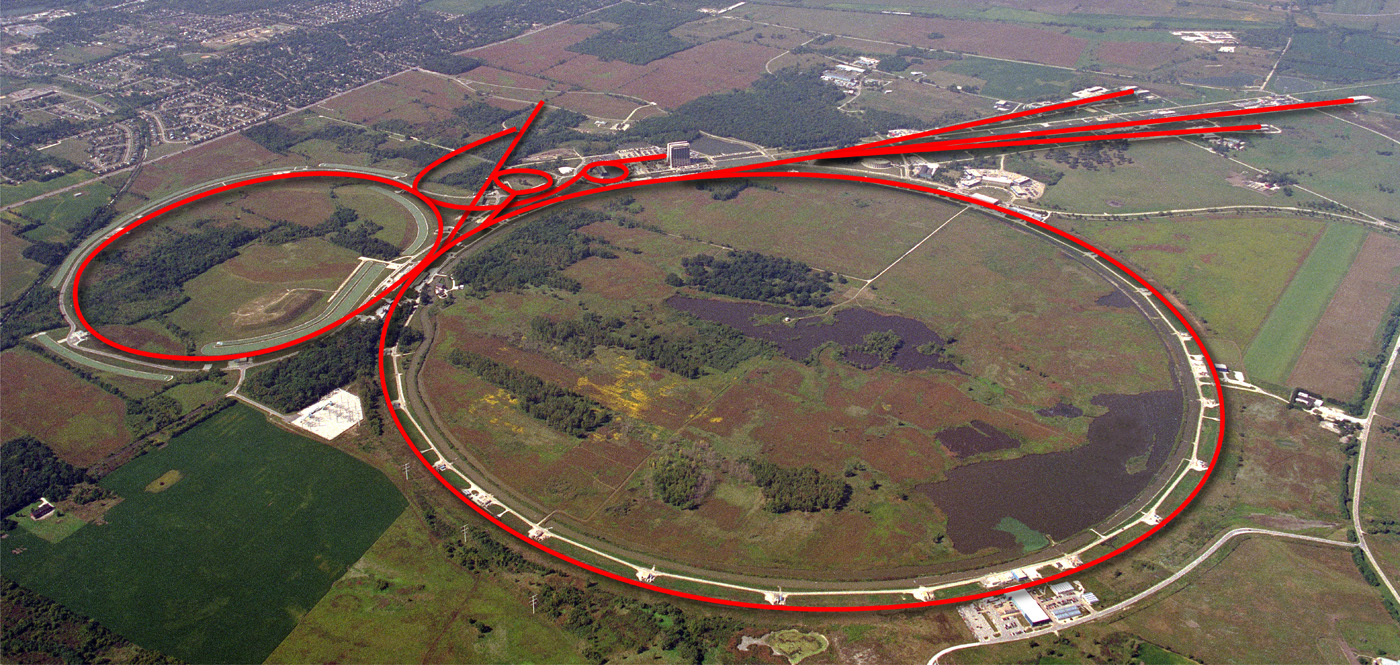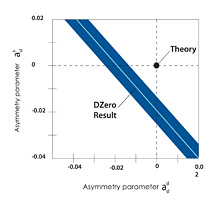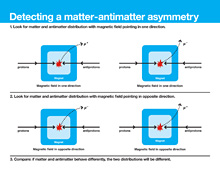   
11
In a mathematically perfect universe,
we would be less than dead;
we
would never have existed.
According to the basic precepts of Einsteinian
relativity and quantum mechanics,
equal amounts of matter and antimatter
should have been created in the Big Bang
and then immediately
annihilated each other in a blaze of lethal energy,
leaving a big fat
goose egg with which to make stars, galaxies and us.
......And yet we exist....
and physicists (among others) would dearly like to know why.....
AND NOW FERMILAB SCIENTIST HAVE DISCOVERED THAT
"the particles known as muons,
which are sort of fat electrons,
are produced in the universe slightly more often
than they produced
pairs of anti-muons."
Joe Lykken, a theorist at Fermilab, said:
“So I would not say that this
announcement is
the equivalent of seeing the face of God,
but it might
turn out to be the toe of God.”
|
 |
| The Fermilab
accelerator complex accelerates protons and antiprotons close to the
speed of light. The Tevatron collider, four miles in circumference,
produces millions of proton-antiproton collisions per second, maximizing
the chance for discovery. Two experiments, CDF and DZero, record the
collisions to look for signs of new particles and subatomic processes.
The DZero detector records particles emerging from high-energy
proton-antiproton collisions produced by the Tevatron. For this
measurement of CP violation, scientists analyzed 10 trillion collisions
collected over the last eight years. The DZero collaboration comprises
about 500 scientists from 19 countries who designed and built the
5,500-ton DZero detector and now collect and reconstruct collision data.
They research a wide range of Standard Model topics and search for new
subatomic phenomena. Credit: DZero collaboration; Fermilab
|
|
|
|
......vEDik TAKE ON SEARCH FOR
THE MEANING OF EXISTENCE.....
God
is the
English
name given to a singular
omnipotent
being
in
theistic
and
deistic
religions
(and other
belief systems)
who is either the
sole
deity
in
monotheism,
or a single
deity in
polytheism.
God is most often conceived of
as the
supernatural
creator
and overseer of the
universe.
Theologians
have ascribed a variety of attributes to the many different
conceptions of God.
The most common among these include
omniscience,
omnipotence,
omnipresence,
omnibenevolence
(perfect
goodness),
divine simplicity,
and eternal and necessary existence. God has also been conceived
as being
incorporeal,
a
personal
being, the source of all
moral obligation,
and the "greatest conceivable existent".
These attributes were all supported to varying degrees by the
early
Jewish,
Christian
and
Muslim
theologian philosophers, including
Maimonides,
Augustine of Hippo,
and
Al-Ghazali,
respectively. Many notable
medieval philosophers
and modern philosophers developed
arguments for the existence of
God. Many notable
philosophers and intellectuals have, in contrast, developed
arguments
against
the existence of God.
Most major religions hold God not as a metaphor, but a being
that influences our day-to-day existences. Many believers allow
for the existence of other, less powerful spiritual beings, and
give them names such as
angels,
saints,
djinni,
demons,
and
devas.....
Many
arguments which attempt to prove or disprove the existence of God
have been proposed by philosophers, theologians, and other thinkers
for many centuries. In
philosophical
terminology, such arguments concern schools of thought on the
epistemology
of the
ontology
of God.
There
are many philosophical issues concerning the existence of God. Some
definitions of God are sometimes nonspecific, while other
definitions can be self-contradictory. Arguments for the existence
of God typically include metaphysical, empirical, inductive, and
subjective types, while others revolve around holes in evolutionary
theory and order and complexity in the
world.
Arguments against the existence of God typically include empirical,
deductive, and inductive types. Conclusions reached include: "God
does not exist" (strong
atheism); "God almost
certainly does not exist" (de
facto
atheism);
"no one knows whether God exists" (agnosticism);
"God exists, but this cannot be proven or disproven" (weak
theism);
and "God exists and this can be proven" (strong
theism).
There are numerous variations on these positions.....
(you can continue enlightening yourself on God by clicking
here......)
|
The subject of GOD
is taken up here in today's news story...simply because one of the
scientists at Fermilab involved in the discovery in today's news story
has invoked "seeing the toes of
GOD in not the face" after the discovery of how we
all creations do exist in spite of the calculus of current science
say creations cannot or should not exist.....
On this knowledge sharing website a glimpse of how this creation we live
in is created, sustained and maintained and cyclically recreated has
been shared by our vED
sciences contributors from their study of in the corpus of
sNskRUt
language texts currently extant of what is called
vED = SCIENECS OF LIFE AND
CREATION.....
The genesis of creation in vED
is stated as God's wish to be many
naam (names) and
ruup (forms) and to do many
kARm with these
naam and
ruup
including creating infinite naam and ruup through being sub-creators of
God......To partake and/or share
YOUR thoughts on this please contact PVAF by email by
clicking
here
and partaking and sharing your knowledge with the rest of the humanity
through publishing your partaking and sharing on this website....
|
|
And now to read the fascinating science news about current science
acknowledging GOD...please
click on the next line......
|
|
.......A New
Clue to Explain Existence.....
(A version of this article
appeared in print on May 18, 2010, on page A1 of the
New York Times. By
DENNIS OVERBYE)
|
Physicists at the
Fermi National Accelerator Laboratory are reporting
that they have discovered a new clue that could help unravel one of the
biggest mysteries of cosmology: why the universe is composed of matter
and not its evil-twin opposite, antimatter. If confirmed, the finding
portends fundamental discoveries at the new
Large Hadron Collider
outside Geneva, as well as a possible explanation for our own existence.
In a mathematically perfect universe, we would be less than dead; we
would never have existed. According to the basic precepts of Einsteinian
relativity and quantum mechanics, equal amounts of matter and antimatter
should have been created in the Big Bang and then immediately
annihilated each other in a blaze of lethal energy, leaving a big fat
goose egg with which to make stars, galaxies and us. And yet we exist,
and physicists (among others) would dearly like to know why.
Sifting data from collisions of protons and antiprotons at Fermilab’s
Tevatron, which until last winter was the most powerful particle
accelerator in the world, the team, known as the DZero collaboration,
found that the fireballs produced pairs of the particles known as muons,
which are sort of fat electrons, slightly more often than they produced
pairs of anti-muons. So the miniature universe inside the accelerator
went from being neutral to being about 1 percent more matter than
antimatter.
“This result may provide an important input for explaining the matter
dominance in our universe,” Guennadi Borissov, a co-leader of the study
from Lancaster University, in England, said in a talk Friday at Fermilab,
in Batavia, Ill. Over the weekend, word spread quickly among physicists.
Maria Spiropulu of CERN and the California Institute of Technology
called the results “very impressive and inexplicable.”
The results have now been posted on the
posted on the Internet and submitted to the Physical Review.
It was Andrei Sakharov, the Russian dissident and physicist, who first
provided a recipe for how matter could prevail over antimatter in the
early universe.
Among his conditions was that there be a slight difference in the
properties of particles and antiparticles known technically as CP
violation. In effect, when the charges and spins of particles are
reversed, they should behave slightly differently.
|
Over the years, physicists have discovered a few examples of CP
violation in rare reactions between subatomic particles that tilt
slightly in favor of matter over antimatter, but “not enough to explain
our existence,” in the words of Gustaaf Brooijmans of Columbia, who is a
member of the DZero team.
The new effect hinges on the behavior of particularly strange particles
called neutral B-mesons, which are famous for not being able to make up
their minds. They oscillate back and forth trillions of times a second
between their regular state and their antimatter state. As it happens,
the mesons, created in the proton-antiproton collisions, seem to go from
their antimatter state to their matter state more rapidly than they go
the other way around, leading to an eventual preponderance of matter
over antimatter of about 1 percent, when they decay to muons.
Whether this is enough to explain our existence is a question that
cannot be answered until the cause of the still-mysterious behavior of
the B-mesons is directly observed, said Dr. Brooijmans, who called the
situation “fairly encouraging.”
The observed preponderance is about 50 times what is predicted by the
Standard Model, the suite of theories that has ruled particle physics
for a generation, meaning that whatever is causing the B-meson to act
this way is “new physics” that physicists have been yearning for almost
as long.
Dr. Brooijmans said that the most likely explanations were some new
particle not predicted by the Standard Model or some new kind of
interaction between particles. Luckily, he said, “this is something we
should be able to poke at with the Large Hadron Collider.”
Neal Weiner of New York University said, “If this holds up, the L.H.C.
is going to be producing some fantastic results.”
Nevertheless, physicists will be holding their breath until the results
are confirmed by other experiments.
Joe Lykken, a theorist at Fermilab, said, “So I would not say that this
announcement is the equivalent of seeing the face of God, but it might
turn out to be the toe of God.”
|
|
.......And now read the really hard core science of the above
news....
Fermilab scientists find evidence for significant
matter-antimatter asymmetry

The
DZero collaboration has found evidence for a new way in which elementary
particles break the matter-antimatter symmetry of nature. This new type
of
CP violation
is in disagreement with the predictions of the theoretical framework
known as the Standard Model of particles and their interactions. The
effect ultimately may help to explain why the universe is filled with
matter while antimatter disappeared shortly after the big bang.
Credit: DZero collaboration
|
FERMILAB:
Press Room Release: May 18, 2010:
Batavia, Illinois, USA
Scientists of the DZero collaboration at the Department of
Energy’s Fermi National Accelerator Laboratory announced Friday, May 14,
that they have found evidence for significant violation of
matter-antimatter symmetry in the behavior of particles containing
bottom quarks beyond what is expected in the current theory, the
Standard Model of particle physics. The
new result, submitted for
publication in Physical Review D by the DZero collaboration, an
international team of 500 physicists, indicates a one percent difference
between the production of pairs of muons and pairs of antimuons in the
decay of B mesons produced in high-energy collisions at Fermilab’s
Tevatron particle collider.
The dominance of matter that we observe in the universe is possible only
if there are differences in the behavior of particles and antiparticles.
Although physicists have observed such differences (called “CP
violation") in particle behavior for decades, these known differences
are much too small to explain the observed dominance of matter over
antimatter in the universe and are fully consistent with the Standard
Model. If confirmed by further observations and analysis, the effect
seen by DZero physicists could represent another step towards
understanding the observed matter dominance by pointing to new physics
phenomena beyond what we know today.
Using unique features of their precision detector and newly developed
analysis methods, the DZero scientists have shown that the probability
that this measurement is consistent with any known effect is below 0.1
percent (3.2 standard deviations).
"This exciting new result provides evidence of deviations from the
present theory in the decays of B mesons, in agreement with earlier
hints," said Dmitri Denisov, co-spokesperson of the DZero experiment,
one of two collider experiments at the Tevatron collider. Last year,
physicists at both Tevatron experiments, DZero and CDF, observed such
hints in studying particles made of a bottom quark and a strange quark.
When matter and anti-matter particles collide in high-energy collisions,
they turn into energy and produce new particles and antiparticles. At
the Fermilab proton-antiproton collider, scientists observe hundreds of
millions every day. Similar processes occurring at the beginning of the
universe should have left us with a universe with equal amounts of
matter and anti-matter. But the world around is made of matter only and
antiparticles can only be produced at colliders, in nuclear reactions or
cosmic rays. “What happened to the antimatter?” is one of the central
questions of 21st–century particle physics.
To obtain the new result, the DZero physicists performed the data
analysis "blind," to avoid any bias based on what they observe. Only
after a long period of verification of the analysis tools, did the DZero
physicists look at the full data set. Experimenters reversed the
polarity of their detector’s magnetic field during data collection to
cancel instrumental effects.
“Many of us felt goose bumps when we saw the result,” said Stefan
Soldner-Rembold, co-spokesperson of DZero. “We knew we were seeing
something beyond what we have seen before and beyond what current
theories can explain.”
The precision of the DZero measurements is still limited by the number
of collisions recorded so far by the experiment. Both CDF and DZero
therefore continue to collect data and refine analyses to address this
and many other fundamental questions.
“The Tevatron collider is operating extremely well, providing Fermilab
scientists with unprecedented levels of data from high energy collisions
to probe nature’s deepest secrets. This interesting result underlines
the importance and scientific potential of the Tevatron program,” said
Dennis Kovar, Associate Director for High Energy Physics in DOE’s Office
of Science.
The DZero result is based on data collected over the last eight years by
the DZero experiment: over 6 inverse femtobarns in total integrated
luminosity, corresponding to hundreds of trillions of collisions between
protons and antiprotons in the Tevatron collider.
“Tevatron collider experiments study high energy collisions in every
detail, from searches for the Higgs boson, to precision measurement of
particle properties, to searches for new and yet unknown laws of nature.
I am delighted to see yet another exciting result from the Tevatron,”
said Fermilab Director Pier Oddone.
DZero is an international experiment of about 500 physicists from 86
institutions in 19 countries. It is supported by the U.S. Department of
Energy, the National Science Foundation and a number of international
funding agencies.
Fermilab is a national laboratory funded by the Office of Science of the
U.S. Department of Energy, operated under contract by Fermi Research
Alliance, LLC.
|

The DZero result is based on the
comparison of the distributions of positively and negatively charged
muons (µ+
and µ-)
emerging from high-energy proton-antiproton collisions produced by the
Tevatron particle collider. A strong magnetic field inside the DZero
particle detector forces the muons that emerge from those collisions to
travel along a curved path. Two muons with opposite charge follow paths
that curve in opposite direction (see graphic). Scientists first
compared the muon distributions when the the magnetic field inside the
DZero detector pointed in one direction (configuration 1) and then
compared their distributions when the magnetic field had been reversed
(configuration 2). If the matter-antimatter symmetry were perfect, the
comparison of the muon distributions
in the two configurations would yield the same result. Instead, the
DZero experiment observed a one-percent deviation, evidence for a
matter-antimatter asymmetry.
Credit: Fermilab
|
|
There are 0 additional comments.
Send your news items
to be posted to news@prajapati-samaj.ca.
|

